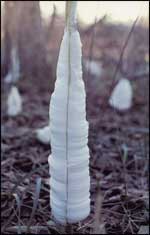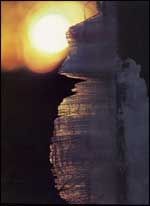Frost Flowers
On that first really cold morning of the year when the air is crisp and temperatures hover below freezing, if you happen to be strolling in the woods or near a creek where frostweed grows, you may get to see nature’s unusual ice sculptures, the frost flowers.
Looking like spun glass or cotton candy, these fragile creations, which are really not flowers at all, last only until the warm rays of the morning sun melt them away. Since their formation and disappearance cover such a short period of time each year, few people have seen them or even know of their existence.

Frost flowers form only when the ground temperature is warm enough for the plant's root system to be active and the air temperature is cold enough to freeze the upward-flowing plant juices. The freezing juices may split open a whole section of stem and push out in a side-curling sheet, or it may emerge from small slits and form long, ribbonlike strands or flowerlike clusters.
Frost flowers develop when air temperatures are freezing but the ground still is warm enough for the plant’s root system to be active. Plant juices flow from these roots up into the stem, where the cold air freezes them. As the moisture in the plant freezes, the ice crystals push out through the stem. They may emerge from a small slit to form thin ribbonlike strands or they may split open a whole section of the stem and push out in a thin, curling sheet. Sometimes several ribbons of ice push out to create a flowerlike petal effect. As long as the juices flow, air temperatures remain low, and the plant is shaded from the sun, these ice crystals continue to form.
Only a few species of plants are capable of producing these icy creations. The frostweed, Verbesinia virginica, which commonly occurs in Texas, is one of them. These waist- to shoulder-high plants grow in dense patches in the moist, shaded soil of river or creek bottoms and form heavy undergrowths in the shade of large trees. This plant also is known as Indian tobacco and tickweed because the dried leaves were once used by Indians as tobacco and people walking through the plants invariably gather a few seed ticks.

Backlit by the sun, the ice crystal threads of frozen plant juices take on a golden glow. What a shame the first sun rays that contribute to this frost flower's beauty also destroy it.
Only a few species of plants are capable of producing these icy creations. The frostweed, Verbesinia virginica, which commonly occurs in Texas, is one of them. These waist- to shoulder-high plants grow in dense patches in the moist, shaded soil of river or creek bottoms and form heavy undergrowths in the shade of large trees. This plant also is known as Indian tobacco and tickweed because the dried leaves were once used by Indians as tobacco and people walking through the plants invariably gather a few seed ticks.
If you want to enjoy the frost flowers in person this year, locate some of the frostweed plants before cold weather arrives. Then, early on that first really cold morning when the temperatures dip below freezing, go back to see if frost flowers are “blooming.” Take along your camera and some flash bulbs so you can share your frost flowers with others who don’t get a chance to see them. Be sure to go early, because they’ll probably be gone by nine.
Ilo
Hiller
1983 Frost Flowers. Young
Naturalist. The Louise
Lindsey Merrick Texas Environment
Series, No. 6, pp. 104-108.
Texas A&M University
Press, College Station.